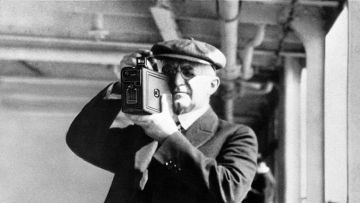
On the morning of July 12, 1854, a young couple from New York was eagerly awaiting the arrival of their third child, hoping for a son to join their two daughters. When George Eastman Kodak was born, his parents’ joy was boundless, especially his wealthy father, a successful farmer and the founder of the renowned "Eastman Commercial College" in the 1840s.
George attended school, but his father fell seriously ill with a brain disease, rapidly worsening until the family had to sell their assets to cover treatment costs. Despite their efforts, his father passed away, leaving the family financially strained. One of George's sisters also developed paralysis, requiring her to use a wheelchair, and his mother had to place George in a boarding school.
Documenting a Journey
At fourteen, George left school, as his teachers consistently noted he was “incompetent.” He took up a job as a night watchman at an insurance company with a modest salary. Later, he moved to work in the accounting department of Rochester Bank. In 1877, upon a friend's suggestion, he ventured into real estate, which was thriving in the Caribbean. Carrying a bulky photographic camera, he set off, unaware that this journey would ignite his passion for photography and lead him to invent the iconic Kodak cameras, forever linking his name to the world of imagery.
The World of Photography
George's early camera, as large as a microwave, used wet collodion plates before the invention of dry film. Despite the camera's bulk, he became captivated by photography, even forgetting the original purpose of his trip. Returning to New York, he immersed himself in the world of photography, learning to make his own photographic plates after reading about their production in Britain. One evening, while engrossed in making a plate, he wondered, “Why not have dry plates?” This idea set him on a three-year journey of experimenting with dry photographic plates using silver bromide, all while working by day in the bank.
Eventually, he created a small machine to mass-produce these plates. When he realized that his banking job hindered his photography business, he resigned, starting his own company to produce the plates. After initial quality issues and financial losses, he persevered, and by 1880, production reached 4,000 plates.
Inventor of a Visual Revolution
In 1888, George Eastman Kodak revolutionized photography by inventing the roll of film, which allowed multiple exposures in one reel. He patented a camera design featuring a rotating film reel, which could capture up to 100 photos. With its compact size and simplicity, the “Kodak Camera” opened photography to non-professionals, enabling people to document life’s moments. Priced at $25 (equivalent to about $760 today), it featured a leather-covered box and a side button for capturing images. The Kodak slogan, “Press the button, we do the rest,” still resonates with photography enthusiasts worldwide.
The Final Message
In 1924, George Eastman Kodak donated $75 million of his wealth (then valued at $160 million) to charitable causes, funding renovations for the Eastman School of Music and building medical and dental institutions in his hometown of Rochester. He also supported dental projects in London, technology institutes in Rochester and Massachusetts, historically Black universities in the southern United States, and health services in impoverished areas of London and other European cities.
In his last years, Eastman endured severe spinal pain, diagnosed as partial paralysis. After his mother’s passing from cancer, he succumbed to depression, and on March 14, 1932, he took his own life, leaving a note that read, “My friends, my work is done, why wait?”
Source: ALBAYAN NEWSPAPER